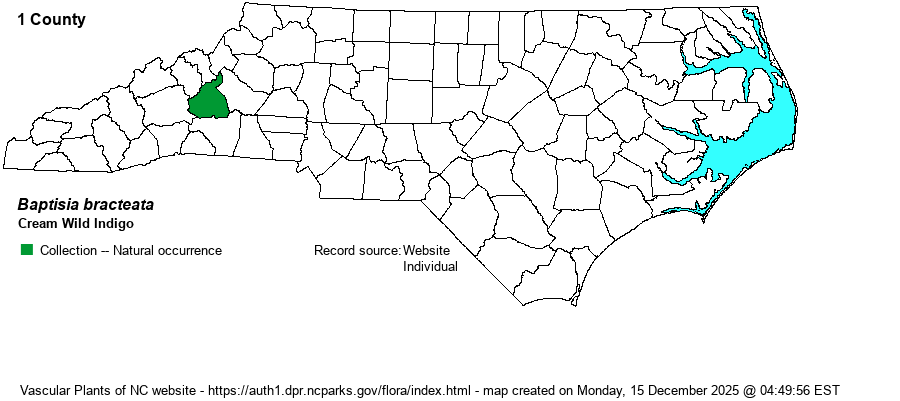| Author | Elliott | |
| Distribution | Of historical occurrence only; formerly collected in McDowell County in 1956. No more recent records. SERNEC lists specimens for the species from Johnston and Moore counties, but these must be erroneously identified (likely as B. cinerea) or are clearly not native that far to the east.
This species has a small range, currently from northern SC and northern AL, south only to central parts of GA and AL. Weakley (2018) considers central populations (TN westward) of this "species" as belonging to B. leucophaea. | |
| Abundance | Of historical occurrence now. However, as it has been recorded in northern SC border counties of Oconee, Pickens, and Spartanburg, and eastward into northeastern SC only one county away from NC (such as Kershaw), it is still to be looked for in the southern Piedmont or Sandhills. It carries a State Special Concern - Historical state status. | |
| Habitat | This is a species of dry, often sandy, wooded borders, open upland woods, and even into dry ridgetops elsewhere. The NC record came from a "recently cleared area (upland)". |
| Phenology | Blooms early for a Baptisia species, in March and April; fruits from May into June. | |
| Identification | This is one of the smaller Baptisia species in the Carolinas, it growing only to about 1-1.5 feet tall. It is rather pubescent, but still somewhat widely branched, with trifoliate leaves, each leaflet being about 1 inch long and about 2/5-inch wide. This is the only Carolina species with creamy yellow (pale yellow) flowers; in addition, the flowers are secund (growing on one side of the flowering stem), and the racemes of flowers are usually spreading or drooping, instead of stiffly erect like some species. On the other hand, each flower is quite large, almost 1 inch long. Each capsule/pod is rather large, about 1.5 inches long and 1/2 as wide. Thus, when it bloom, it can be instantly identified, in case it were to ever be found again in NC. | |
| Taxonomic Comments | Aa with several others in the genus, some references -- including Weakley (2018) -- tend to split out more westerly taxa in the "species" (broad sense) into other species. Some references have the more westerly taxon in the broad sense B. bracteata as B. bracteata var. leucophaea, meaning that they would have the eastern taxon (including NC) as B. bracteata var. bracteata.
| |
| Other Common Name(s) | Creamy Wild Indigo, Cream False Indigo, Longbract Wild Indigo | |
| State Rank | SH | |
| Global Rank | G4G5T4? [G4?] | |
| State Status | SC-H | |
| US Status | | |
| USACE-agcp | | |
| USACE-emp | | |

